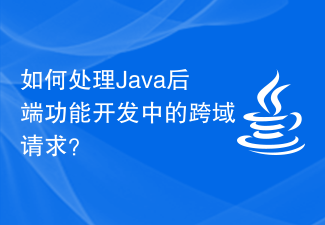
How to implement distributed deployment in Java back-end function development?
With the rapid development of Internet technology and the widespread promotion of applications, the demand for large-scale systems is also increasing. In order to cope with this demand, the traditional single-machine architecture can no longer meet the requirements of high concurrency, high availability, high scalability, and high performance. Therefore, distributed architecture has become one of the effective means to solve these problems. This article will introduce how to implement distributed deployment in Java back-end development and give corresponding code examples.
1. Overview of distributed systems
A distributed system refers to a cluster system composed of multiple independent computers. These computers are connected to each other through the network and work together to complete a common task. Distributed systems have the following characteristics:
- High availability: Each node of the system can back up and redundant each other. When some nodes fail, they can be quickly switched to other nodes to ensure the continuity of services. Availability.
- Scalability: The nodes of the system can be added or reduced according to needs to improve the system's processing capacity and load balancing performance.
- Fault tolerance: Through redundant nodes and mechanisms, automatic detection and recovery of faults are realized to ensure the continuous and stable operation of the system.
- Multi-activity in different locations: Nodes in different regions are connected through the network and can provide services at the same time, thereby achieving better performance and user experience.
2. Distributed deployment architecture design
In Java back-end development, the following common distributed deployment architecture designs can be used:
- Master-slave Architecture (active-standby mode): One master node provides services, and multiple backup nodes serve as redundancy for the master node. When the master node fails, the backup nodes automatically take over the service.
- Load balancing architecture: Evenly distribute user requests to multiple nodes through the load balancer to improve the concurrency performance and stability of the system.
- Distributed cache architecture: Use cache servers to store and read data, reduce the load on the database, and improve the response speed of the system.
- Distributed database architecture: Store database data shards on multiple nodes to improve the read and write performance and capacity of the database.
3. Distributed deployment instance code example
- Master-slave architecture example
Master node code:
public class MainNode {
public static void main(String[] args) {
// 主节点启动服务
MasterServer server = new MasterServer();
server.start();
}
}Backup node code:
public class BackupNode {
public static void main(String[] args) {
// 备份节点启动服务
BackupServer server = new BackupServer();
server.start();
}
}- Load balancing architecture example
Load balancer code:
public class LoadBalancer {
private List<Node> nodes;
public LoadBalancer(List<Node> nodes) {
this.nodes = nodes;
}
public void forwardRequest(Request request) {
Node selectedNode = selectNode();
selectedNode.processRequest(request);
}
private Node selectNode() {
// 根据负载情况选择节点
// 简单示例,随机选择节点
Random rand = new Random();
int index = rand.nextInt(nodes.size());
return nodes.get(index);
}
}Node code:
public class Node {
public void processRequest(Request request) {
// 处理请求
}
}- Distributed cache architecture example
Cache server code:
public class CacheServer {
private Map<String, Object> cache;
public CacheServer() {
this.cache = new ConcurrentHashMap<>();
}
public Object get(String key) {
return cache.get(key);
}
public void put(String key, Object value) {
cache.put(key, value);
}
public void remove(String key) {
cache.remove(key);
}
}- Distributed database architecture example
Database node code:
public class DatabaseNode {
private Map<String, Object> data;
public DatabaseNode() {
this.data = new ConcurrentHashMap<>();
}
public Object getData(String key) {
return data.get(key);
}
public void putData(String key, Object value) {
data.put(key, value);
}
public void removeData(String key) {
data.remove(key);
}
}The above are sample codes for several common distributed deployment architecture designs. Through these examples, you can better understand and practice how to implement distributed deployment in Java back-end development. Of course, in actual applications, more factors may need to be considered, such as data consistency, system monitoring, etc. I hope this article can be helpful to you, and I also hope you can further study and practice the development of distributed systems.
The above is the detailed content of How to implement distributed deployment in Java back-end function development?. For more information, please follow other related articles on the PHP Chinese website!
 如何在PHP后端功能开发中合理应用设计模式?Aug 07, 2023 am 10:34 AM
如何在PHP后端功能开发中合理应用设计模式?Aug 07, 2023 am 10:34 AM如何在PHP后端功能开发中合理应用设计模式?设计模式是一种经过实践证明的解决特定问题的方案模板,可以用于构建可复用的代码,在开发过程中提高可维护性和可扩展性。在PHP后端功能开发中,合理应用设计模式可以帮助我们更好地组织和管理代码,提高代码质量和开发效率。本文将介绍常用的设计模式,并给出相应的PHP代码示例。单例模式(Singleton)单例模式适用于需要保
 如何处理Java后端功能开发中的跨域请求?Aug 05, 2023 am 09:40 AM
如何处理Java后端功能开发中的跨域请求?Aug 05, 2023 am 09:40 AM如何处理Java后端功能开发中的跨域请求?在前后端分离的开发模式下,前端通过JavaScript发送请求到后端API接口获取数据是非常常见的场景。然而,由于浏览器的同源策略,存在着跨域请求的限制。跨域请求是指前端页面通过AJAX等方式请求不同域名、不同端口或不同协议的服务器。本文将介绍一种处理Java后端功能开发中跨域请求的常用方法,并附带代码示例。解决跨域
 如何解决Java后端功能开发中的数据库事务问题?Aug 04, 2023 pm 07:45 PM
如何解决Java后端功能开发中的数据库事务问题?Aug 04, 2023 pm 07:45 PM如何解决Java后端功能开发中的数据库事务问题?在Java后端功能开发中,涉及到数据库操作的功能很常见。而在数据库操作中,事务是一项非常重要的概念。事务是指由一系列数据库操作组成的逻辑单元,它要么完全执行,要么完全不执行。在实际应用中,我们经常需要确保一组相关的数据库操作要么全部成功执行,要么全部回滚,以保持数据的一致性和可靠性。那么,如何在Java后端开发
 如何优化PHP后端功能开发中的网络请求?Aug 06, 2023 pm 12:25 PM
如何优化PHP后端功能开发中的网络请求?Aug 06, 2023 pm 12:25 PM如何优化PHP后端功能开发中的网络请求?网络请求是PHP后端开发中经常遇到的任务之一。随着互联网的发展,人们对于网页的性能要求也越来越高,因此优化网络请求成为了PHP开发中的一项重要任务。本文将介绍一些优化网络请求的方法,并给出相应的代码示例。使用缓存缓存是一种常见的优化网络请求的方法。通过缓存来保存经常被请求的数据,可以减少数据库或其他数据源的访问次数,提
 如何利用PHP后端功能开发实现Web API?Aug 04, 2023 pm 03:09 PM
如何利用PHP后端功能开发实现Web API?Aug 04, 2023 pm 03:09 PM如何利用PHP后端功能开发实现WebAPI?随着互联网的发展,WebAPI的重要性越来越被人们所认识和重视。WebAPI是一种应用程序编程接口,用于允许不同的软件应用之间进行信息交换和互操作。PHP作为一种广泛应用于Web开发的后端语言,也可以很好地用于开发和实现WebAPI。本文将介绍如何使用PHP后端功能来实现一个简单的WebAPI,并给出相关
 如何在Java后端功能开发中实现数据持久化?Aug 07, 2023 am 10:21 AM
如何在Java后端功能开发中实现数据持久化?Aug 07, 2023 am 10:21 AM如何在Java后端功能开发中实现数据持久化?随着互联网的快速发展,数据成为了一个组织和企业不可忽视的核心资产。在Java后端开发中,实现数据持久化是一项重要的任务。本文将介绍几种常见的数据持久化方式,并使用代码示例来展示如何在Java中实现数据持久化。一、关系型数据库关系型数据库是最常见的数据持久化方式之一。在Java中,我们可以使用JDBC(JavaDa
 如何在Java后端功能开发中实现搜索功能?Aug 05, 2023 am 11:09 AM
如何在Java后端功能开发中实现搜索功能?Aug 05, 2023 am 11:09 AM如何在Java后端功能开发中实现搜索功能?搜索功能是现代应用程序中必不可少的一个重要功能。无论是在电商平台中搜索商品,还是在社交媒体中搜索朋友,搜索功能都为用户提供了便捷和高效的信息获取方式。在Java后端开发中,我们可以利用各种技术和库来实现搜索功能。本文将介绍一种常用的实现搜索功能的方法,并以Java语言为例给出代码示例。在Java后端开发中,我们通常会
 如何使用C++编写高级嵌入式系统的各类功能Aug 26, 2023 pm 05:18 PM
如何使用C++编写高级嵌入式系统的各类功能Aug 26, 2023 pm 05:18 PM如何使用C++编写高级嵌入式系统的各类功能在如今飞速发展的科技时代,嵌入式系统在各个领域的应用越来越广泛,其对高级功能的需求也日益增加。C++作为一种跨平台的编程语言,被广泛应用于嵌入式系统的开发中。本文将介绍如何使用C++编写高级嵌入式系统的各类功能,并且给出相应的代码示例。多线程编程多线程编程在嵌入式系统中非常有用,它可以提高系统的并发性和响应性。C++


Hot AI Tools

Undresser.AI Undress
AI-powered app for creating realistic nude photos

AI Clothes Remover
Online AI tool for removing clothes from photos.

Undress AI Tool
Undress images for free

Clothoff.io
AI clothes remover

AI Hentai Generator
Generate AI Hentai for free.

Hot Article

Hot Tools

VSCode Windows 64-bit Download
A free and powerful IDE editor launched by Microsoft

SublimeText3 Mac version
God-level code editing software (SublimeText3)

Zend Studio 13.0.1
Powerful PHP integrated development environment

mPDF
mPDF is a PHP library that can generate PDF files from UTF-8 encoded HTML. The original author, Ian Back, wrote mPDF to output PDF files "on the fly" from his website and handle different languages. It is slower than original scripts like HTML2FPDF and produces larger files when using Unicode fonts, but supports CSS styles etc. and has a lot of enhancements. Supports almost all languages, including RTL (Arabic and Hebrew) and CJK (Chinese, Japanese and Korean). Supports nested block-level elements (such as P, DIV),

SAP NetWeaver Server Adapter for Eclipse
Integrate Eclipse with SAP NetWeaver application server.






